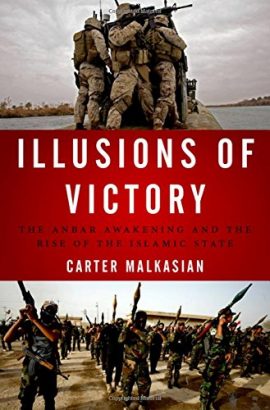Carter Malkasian sets out in Illusions of Victory: The Anbar Awakening and the Rise of the Islamic State to upend the conventional understanding of the campaign against the Islamic State (IS) movement, known at the time as al-Qaeda in Iraq (AQI), in Anbar province of western Iraq.
Malkasian was a Marine who served in Iraq between 2003 and 2006, most of the time in Anbar as an advisor on counterinsurgency. The book draws on these experiences, though Malkasian left Iraq just before the formal onset of the Anbar Awakening. Focused on the local, in conformity with Malkasian’s (convincing) argument that the Iraqis matter most in this story, the book is concise.
There are seven short chapters, covering: the arguments over the historiography of the Awakening; the gradual takeover of Anbar province by the jihadists between 2003 and 2006 and the reasons for that, related to the tribal system, demographics, and public opinion; the stirrings of tribal and insurgent resistance against IS and why it failed; the US adaptations and offensive operations in Ramadi in the second half of 2006 that coincided with the beginning of the Awakening and preceded the Surge of US troops in 2007; the Awakening’s apparent success after its beginning in September 2006 and the clearance of Ramadi in March 2007; the revival of IS and the collapse of the Awakening movement; and the lessons to be drawn.
RELIGION AND THE SHADOW OF SADDAM
One of the takeaway messages from Malkasian is that the Sunnis of Anbar had a lot more sympathy with IS — at least if the alternative was either Americans or an Iranian-influenced Shi’a-led government — than many histories of the Awakening suggest. Even during the ‘strongest periods of Ba’ath secularism, religious leaders had maintained an enduring influence,’ Malkasian writes. ‘Compared to the fragmented nature of tribes, Islam was unifying. Compared to secular strongmen and nationalism, Islam was permanent’.
The insurgency gathered around the mosques and the Imams after the fall of Saddam Hussein, and it was the Ba’ath regime that laid the groundwork for this to happen. First, as Malkasian notes, the ‘modernising’ policies of the early Saddam years worked, breaking the power of the Sheiks (tribal leaders) and leading to urbanisation. In the cities, Imams drew congregations that overshadowed the sheiks. Second, as Saddam Islamised his regime from the late 1980s onward, one crucial aspect was the extension of patronage to more junior clerics, altering the fabric of the Sunni areas by making them more religious and empowering mid-level Imams as social leaders.
This was the situation the US and her allies found in 2003, and it eased IS’s rise. The jihadist networks had been building in Iraq long before the invasion, and in the aftermath, when they presented themselves in Islamic terms to a population enraged at the loss of primacy and the intrusion of infidel foreigners into their midst, they found a receptive audience that had been increasingly framing its identity in sectarian and religious terms.
THE SPOILS OF WAR
Related to this, Malkasian notes that the triggers for the tribal uprising against IS were rather less romantic than some descriptions, including their own, would have one believe. Power and honour played crucial roles. Power took informal shapes, notably controlling the smuggling routes to Jordan and Syria. There were more formal avenues, too. The governor of Anbar province was Ma’amun Sami Rashid al-Alwani, a member of the Iraqi Islamic Party, the local branch of the Muslim Brotherhood, rejected at a popular level as insufficiently Islamist and rejected by the tribal leaders as a competitor. Tellingly, the first demand of the Awakening charter was al-Alwani’s removal. More broadly, the battles at Fallujah in 2004 had devastated the more local ‘resistance’ groups in Anbar; many of the tribal leaders fled to Jordan and a number of insurgent groups buckled and joined IS.
This left a vacuum for smaller tribes to exploit. In stepped Abdul Sittar al-Rishawi and his brother Ahmed from the Albu Risha tribe, backed by Khalid Arak Ehtami and his son, Tahir Bedawi, from the Albu Ali Jassim tribe, and Hamid Farhan al-Hais and Colonel Tariq Yusef Muhammad from the Albu Thiyab tribe. Notably, all of these men had early problems with ever more IS dominated insurgency. Col Muhammad, for example, had run afoul of the Saddam regime in the 1990s, and was thus at some emotional distance from a resistance movement at ease with a Ba’athist restoration. From this small cadre of just a few hundred the Awakening movement grew.
It is often said that the tribes rose against the brutality of IS, and there is a sense in which this is true. For example, IS’s murder of al-Rishawi’s father was key in motivating him. The stories of indiscriminate atrocities by IS before late 2006, however, are, in Malkasian’s judgement, largely mythical. Those ’collaborating’ with the government or the Americans were ruthlessly dealt with. IS managed to dismantle the ‘provincial security council,’ the first body in Ramadi to countenance arm’s length dealings with the Americans to handle IS, in just two months between January and March 2006, after it was set up on 28 November 2005, with a highly effective and discriminate campaign of assassination. But it was only after the Awakening began that IS resorted to suicide bombings in crowds of Sunni civilians in Anbar.
The car bombings, and IS’s addition of chlorine gas to this disgusting tactic, helped fuel the anti-jihadist resistance in late 2006. But why? If half-a-dozen assassinations, the bombing of a police station, and the demolition of a Sheik’s house could disperse the anti-IS resistance in Ramadi in early 2006, why would greater cruelty spur greater resistance in late 2006? Malkasian points to the asabiyya, i.e. the solidarity or cohesion, of the Awakening tribes, as the difference-maker.
The Albu Risha were a compact tribe based east of the city of Ramadi, giving them a physical space to defend and a population that was harder to penetrate because it was more socially united. The big tribes had to contend with IS infiltration on a wide scale, especially among their youth, who were often the assassins of their elders. In using the younger members of one tribe to challenge leading Sheikhs from the same tribe, IS was able to draw on men driven by a desire for status and money, as much as ideology. The result was that the close social bonds in the smaller tribes motivated their leaders to pursue the tribal custom of revenge in a way many larger tribes did not, so IS’s killings escalated feuds, rather than suppressing them.
These factors can be seen in al-Qaim, in the far west of Anbar province near the Syrian border, where, in 2005, there was a foreshadowing of the Awakening. The Albu Mahal tribe dominated the area and IS, in a pattern repeated many times since, played on the resentment of two smaller tribes, Albu Karbuli and Albu Salman, to make inroads. On that occasion, IS overcame the tribal resistance because the US was unable, because of resource constraints, to provide support in that remote area.
UNABLE TO STAND ALONE
This leads us to Malkasian’s central argument: ‘At no point was the awakening movement self-sustaining’. The Awakening Sheikhs, in Malkasian’s telling, were an elite ruling over populations that was dubious of the course taken in siding with the Americans, but were held in place so long as there was a supply of American resources and the Shi’a militias were kept at bay.
In 2012, with the Americans gone, protests broke out in Anbar against the central government that had been witch-hunting Sunnis out of the government and security forces, helping to open political and military space for IS. The Awakening Sheikhs faced a devil’s choice. Malkasian writes:
The tribal leaders depended on the government for the money, salaries, and privileges to dominate Anbar. The protests pressured them to relinquish their ties to the government in order to avoid immediate discredit and loss of their tribesmen’s support, which would in turn imperil their long-term authority over the province.
As Malkasian explains, the Awakening Sheikhs did not side with Baghdad, and so opened up for themselves a separate set of problems:
By supporting the protests … tribal leaders had to accept mass popular activity, with thousands of people out on the streets. They had to allow other leaders to speak to the people, thus opening their own authority to challenge. Religious leaders and [IS] supporters who had formerly been under the tribal thumb could come out, rally the people, and implicitly challenge the tribal leaders, who were now without government support.
Tribal movements are generally fractious (as America found during its very first foreign expedition) and this dynamic swiftly reasserted itself in Anbar after 2007. It did not dissipate even in the face of IS rampaging through the province in 2013. The entry of Iraqi government troops and Iranian-controlled sectarian Shi’a militias at that same moment made the Awakening leaders’ position untenable. Squeezed between IS and Baghdad, the anti-IS Sunni structures disintegrated. As Malkasian puts it, ‘Without the tribes, the army lacked numbers and popular support. Without the army, the tribes lacked heavy firepower. Divided, they fell.’
CONCLUSION
The United States misread the Surge of troops in 2007 and Anbar Awakening as a completed task. Measuring by metrics like loss of territory, elimination of commanders, and the drying up of money and recruits — which are still being used this time around — IS was believed dead. In reality, IS was not as badly wounded as it seemed and the Awakening was a process that had to be sustained. That required American forces on the ground to build trust with the Sheikhs, money, and the tribes’ own willingness to fight.
Malkasian argues that the success the Awakening had was built on short-term thinking that ignored immovable underlying trends, in particular sectarianism, religiosity, and the tribal system itself, which Malkasian argues is ‘inherently unstable’. What appeared to be working after 2007 collapsed in 2013. From this vantage point, ‘Anbar is the foremost example of how the greatest successes of intervention can be evanescent’. Malkasian does not conclude from this that intervention is never necessary, just that it should be understood as a long-term endeavour. His main point is that these greater costs should be advertised upfront and raise the bar so as to discourage intervention.
Malkasian clearly believes the effort was wholly wasted, but one can accept his points—on the need for better thought-out interventions, the US needing to curb its tendency to abandon missions before victory and the fragility of the Awakening and come to the opposite conclusion. As Malkasian notes, the Awakening bought five years of relative stability and hindered the re-emergence of IS, and to have kept that up would ‘not [have required] tens of thousands of troops but … thousands, along with funding of tribes’. Such constancy is not beyond the U.S., economically and militarily, even if it is politically.
Perhaps tribal competition, plus IS’s assassination campaigns and popular appeal, would always have torn the Awakening apart from the inside, even if the US remained in Iraq and Baghdad had not undermined the tribal militias. The rise of the ‘caliphate,’ the global campaign of terror, and the destruction of Ramadi itself, bombed to rubble because the US relied on its own air power and Iraqi ground forces from outside Anbar province that now occupy the city, do allow one to wonder, though, if there was not something in the Awakening worth retaining.





































Comments are closed.